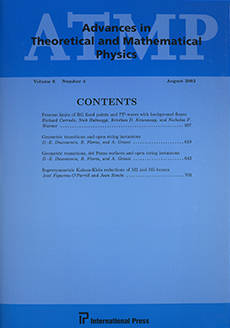Abstract
We study the connection between topological strings and contact homology recently proposed in the context of knot invariants. In particular, we establish the proposed relation between the Gromov-Witten disk amplitudes of a Lagrangian associated to a knot and augmentations of its contact homology algebra. This also implies the equality between the $Q$-deformed $A$-polynomial and the augmentation polynomial of knot contact homology (in the irreducible case). We also generalize this relation to the case of links and to higher rank representations for knots. The generalization involves a study of the quantum moduli space of special Lagrangian branes with higher Betti numbers probing the Calabi-Yau. This leads to an extension of SYZ, and a new notion of mirror symmetry, involving higher dimensional mirrors. The mirror theory is a topological string, related to D-modules, which we call the “D-model”. In the present setting, the mirror manifold is the augmentation variety of the link. Connecting further to contact geometry, we study intersection properties of branches of the augmentation variety guided by the relation to D-modules. This study leads us to propose concrete geometric constructions of Lagrangian fillings for links. We also relate the augmentation variety with the large $N$ limit of the colored HOMFLY, which we conjecture to be related to a $Q$-deformation of the extension of $A$-polynomials associated with the link complement.
Citation
Mina Aganagic. Tobias Ekholm. Lenhard Ng. Cumrun Vafa. "Topological strings, D-model, and knot contact homology." Adv. Theor. Math. Phys. 18 (4) 827 - 956, August 2014.
Information





